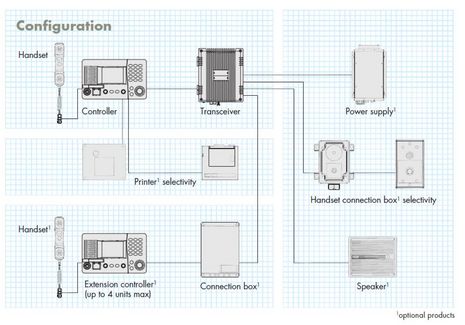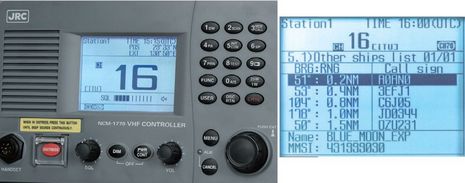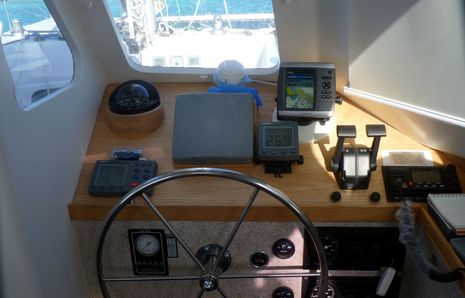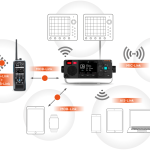JRC JHS-770S/780D, “Direct call by AIS”
Thanks to Sandy Daugherty over on the Forums, I now know that JRC has introduced a VHF radio series that can easily make direct DSC calls to AIS targets. They are most definitely big ship radios (see diagram below), and they do AIS calling in a way I hadn’t anticipated, but still…
Judging from the screen shot above and the specs, the JRC radios seem somewhat like the MKD displays on Class A AIS transponders. They receive all the target information via IEC-61162-2 (AKA NMEA 0183 high speed) and can list the targets at least by range, and probably other parameters. So JRC does the work of parsing out the vessel’s MMSI number and placing the DSC call on your chosen channel all within the radio. This is a different approach than, say, the Simrad AI50 Class B transponder, which let’s you select a target on screen and then initiate a DSC call on a “compatible” VHF radio that’s on the same SimNet (N2K) network. It’s also different than the MFD interfaces that I think will use N2K to accomplish the same end (but haven’t seen yet ;-).
There are many ways to skin this cat, but surely it’s going to get even easier for AIS-aware vessels to talk to each other. Of course we should all be aware that not all other vessels are AIS aware, even some that are carrying Class A transponders (because they only have an MKD). And I guess it’s possible, thanks to some charting software developers, that you’ll see Class B equipped vessels that won’t see your Class B because they’re filtering it out!
Incidentally, the new JRC radios also record, and can replay, 120 seconds of whatever last broke squelch, a feature that sounds very much like Cobra’s Rewind and the Last Call amplified speaker. The latter company may be defunct (and my sample broke), but this is an excellent feature that I wish other VHF manufacturers would incorporate.














AIS Calling.
A quick note that even folks ignoring class B AIS targets can be hailed using these systems.
MMSI / AIS calling uses DSC which is separate from AIS and any filtering options, but shares the MMSI as an id, which allows this slick bit of calling.
As AIS Class B becomes standard and boat counts increase, I think you’ll see more and more Class B filtering especially in races. But folks def will track class A so they can avoid (or take advantage of) large ship transits as part of racing.
MMSI calling based on AIS is really going to be a sweet combo, and will I think significantly improve safety. What better way to communicate intention (especially before entering a turn etc) then via VHF? I’m a fan 🙂
Cannot send message via the forums on Panbo??
Thanks this happening 5/2/09 at 10:10 AM EST
Message is:
Want to add AIS A and B to a NMEA 2000 network that feeds a new Garmin 5212. What units are available to do this?
Also, want to feed the NMEA 2000 info from ultrasonic wind sensor on the mast to a Raymarine Auto Pilot 6000+ with a 100-controller unit. This auto pilot unit circa 2001 only has NMEA 183 input/output. Is there a “box” that translates NMEA 2000 to NMEA 183?
We have installed a complete new NMEA 2000 network except for the autopilot. We put in all NMEA 2000 equipment such as Maratron ultrasonic wind sensor, Garmin 18hd radar, Garmin Xm radio / weather, Garmin 22 sonar / fish finder, Garmin Network expander, two Garmin GMI 10’s and the Garmin 5212 GPS with NMEA 2000 gps antenna. Also on this NMEA 2000 network there are two NMEA 2000 Offshore Systems fuel senders, with matching digital read out fuel deck fillers…these are very nice. We also removed the original Yanmar engine control panel at the helm and replaced it with a start/stop switch and all engine data shows up on the NMEA 2000 network Garmin displays.
Jeffrey
@Jeffrey:
Whaddaya mean, AIS A and B? A receiver that handles A and B? A Class A transponder? A class B transponder?
The simplest “box” that translates NMEA 0183 to 2000 and vice-versa is a Simrad AT10, which not even expensive ($80 or so). As it has a tail on the 0183 side but Simnet connectors for the 2000 side you need a Simrad NMEA 2000 converter cable which will hook into your Garmin network’s standard Micro connectors. This adds another $40.
Regards,
Kees
Jeffrey, I don’t think there are any AIS receivers that output target data in NMEA 2000 format (yet). But there are three Class B transponders that do: two from Navico, and the new one from Raymarine.
You may find that the 5212 will not understand N2K AIS info now, but, if not, I’m confident that a software upgrade will fix that soon. Plus the mentioned transponders also output to 0183 if you need the install to work right now.
Kees is right about the Simrad AT10. It’s data translation abilities are limited, but it should work for your autopilot. If you search Panbo for any of these gear, you’ll find more info.
On the 5212 you can dedicate one of the NMEA 0183 (com 1,2,3, or 4)ports to AIS and set the rate seperately to 38,400 for a very reliable AIS input/output. This data will then be shared to any other networked Garmin chartplotters on board.
Unless NMEA decides on pgns to carry AIS data (and I don’t know if they have or haven’t) its most likely that the next few radios with the features of the JRC above will speak NMEA 0183 at 38,400. 183 isn’t dead yet.
I wish someone who does know could tell us N2K can or will do the job. I realize we are talking about a lot of data.
Sandy, NMEA 2000 has had AIS PGNs for a long time, except that NMEA was slow to a make a modification for the Class B static data message that was added to AIS late in the game.
Following on from Ben’s comment above, NMEA2K has full support for Class A AIS, but the current specification does not include a PGN to carry Class B static data.
I understand NMEA are updating the N2k spec to include this, but nothing has been confirmed yet.
The existing Class B AIS transceivers supporting N2k (Navico and Raymarine) get around this using proprietary N2k messages for Class B Static data. This means you won’t get all the data displayed on a Garmin system should you connect one of these devices. NMEA0183 to N2k converters will suffer the same issue until the NMEA updates the spec….
DSC has been around for 10 years and AIS for at least 5, so why does it take so long to see some radios with this functionality come to market? This is the most basic sort of evolutionary product development. This is the kind of functionality that would cause me to buy a new radio, assuming I can use the existing cabling for my remote mics.
We have a JRC B&W LCD 2KW radar which is perfectly adequate for our purposes….it outputs/interfaces to NMEA 0183. We’d now like a Class B AIS transceiver to integrate to this screen, or better yet, a chart plotter at the helm which will display both AIS and radar overlays. Such a beast exist? Do we have to worry about true compatibility if we get “parts” of such a system from different networkds? Thanks in advance for any help you can give us.
Jeff and Elise from SeaSpan
Sorry, Jeff & Elise, it’s extremely doubtful that your JRC radar knows how to plot AIS targets. That only happened on MFD during the last few years, and still hasn’t happened on any small standalone radars I know of (there aren’t many left). On the other hand, just about every current MFD can overlay radar and AIS, but you’ll have to get a radome that works with the same brand of MFD.